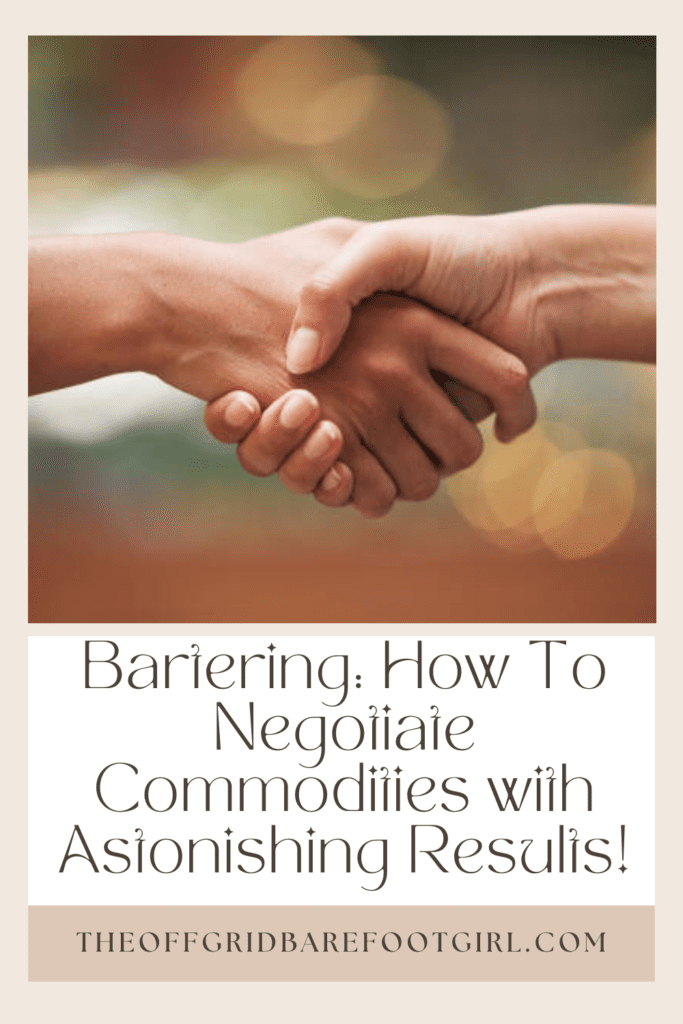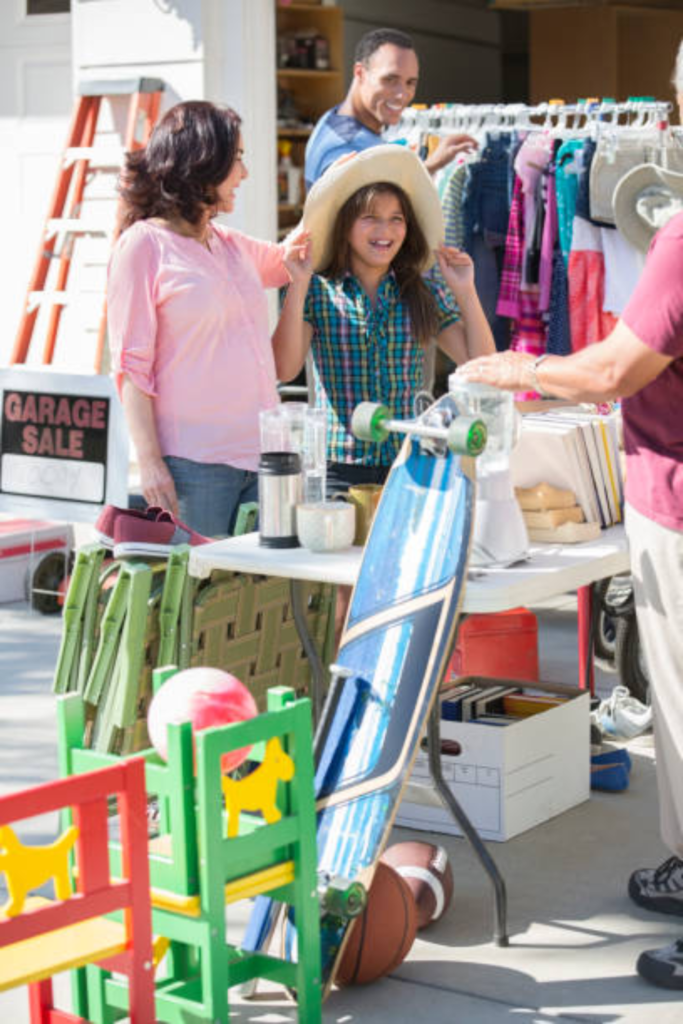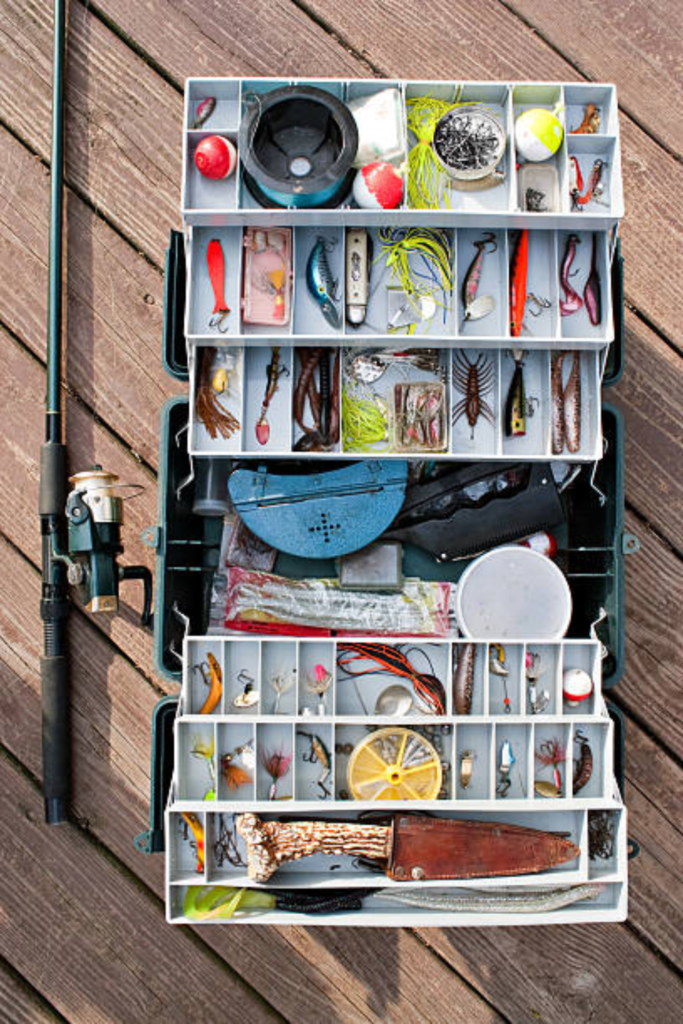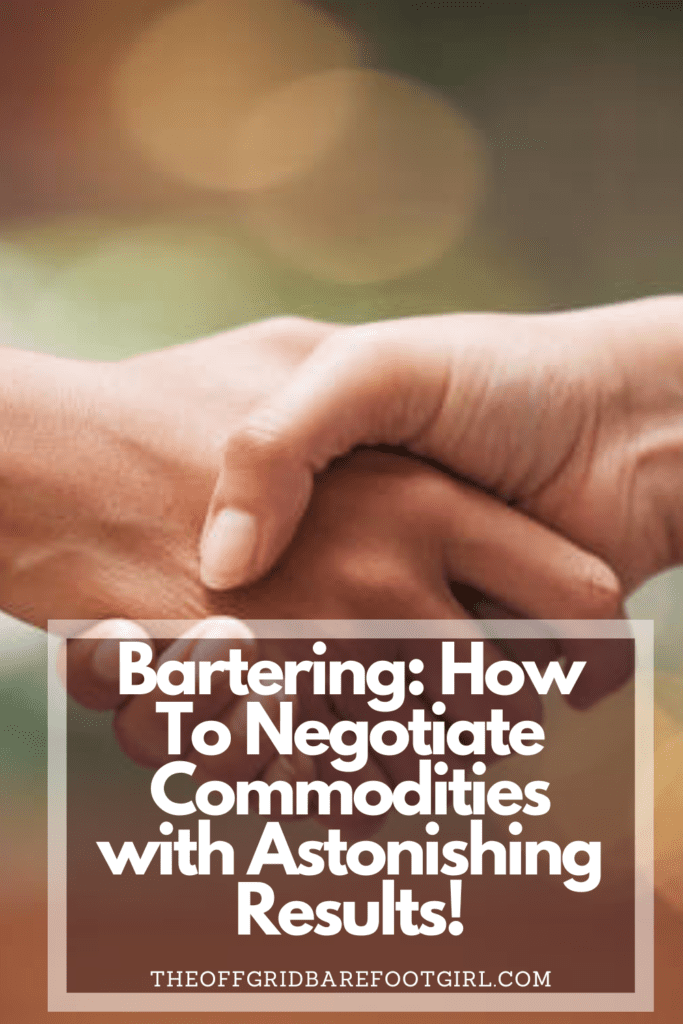Unlock the Power of Bartering! Discover proven strategies to negotiate commodities effectively, maximize value in every trade, and walk away with deals that exceed expectations. Perfect for anyone looking to save money and trade smarter.
Bartering, a timeless practice as old as civilization itself, remains a powerful method of trade that goes beyond mere currency. As someone passionate about these ancient practices, I’m excited to share the complexity of human interaction with you. Understanding the psychology behind negotiation, identifying valuable commodities, mastering effective communication, leveraging power dynamics, and overcoming challenges are all essential components of successful bartering.
Through this article, I will discuss the intricacies of bartering and offer insights and strategies to illuminate the art of negotiation and empower you to engage in fruitful bartering transactions. While I talk a lot about bartering off-grid, you can use bartering in any situation. Let’s unlock the astonishing potential of bartering skills we still need today!
This is a pinnable post. Tap or hover over any image in this post to pin to your Pinterest Boards.

Introduction to Bartering

Imagine living off-grid, where every exchange is not just a transaction, but a step towards self-sufficiency and sustainability. Away from the conventional market system, bartering emerges as a beacon of eco-friendly exchange. It’s more than just trading goods; it’s about fostering a community that thrives on mutual support and shared values.
This article explores how bartering can be integral to off-grid living, transforming the way we view consumption and community. Let’s discuss how we can improve our bartering skills, where every trade enriches our lives and the environment, making each exchange a testament to sustainable living.
The Art of Bartering: A Timeless Method of Trade
Bartering is one of humanity’s oldest forms of transaction, predating the invention of currency by centuries. In its essence, bartering is a straight-up trade: I give something I have in exchange for something you have. No money changes hands, just goods or services. It sounds simple, right? Because at its core, it really is.
Imagine you’ve got a garden full of vegetables but no eggs, while your neighbor’s chickens are in full laying mode, but they’re short on greens. You two decide on a swap, and just like that, a barter is made. It’s direct, it’s fair, and both parties walk away happy.
This practice might seem quaint or outdated in today’s digital and global economy, but in off-grid living, it makes a powerful comeback as a sustainable lifestyle choice. Rejecting the complexity of modern finance in favor of trading goods and services not only simplifies transactions but also fosters a closer connection to the value of what we consume and offer. Bartering, in this context, isn’t just a transaction. It’s a statement about the kind of world we want to live in.
An Example of How I Bartered with My Clients
You do not need money for bartering. I can remember a time when I bartered service for service with one of my clients. You see, I used to be a home daycare provider when my kids were very young. One of my clients, whom I babysat for, was a photographer. We decided to exchange our services as one of the payments and left money out of the exchange. I agreed to care for her young child for a pay period, and she agreed to take professional photos of my kids, which is about the cost of the childcare payment for a professional photo package of my kids.
So, you see, she was able to get free childcare for her child, and I was able to get a free photography session for my kids. We both agree with this exchange, which was a successful bartering transaction between us. I share that experience only to help you think of ways you can barter in your life when money is tight. Just simply think of what you want and what you are able to offer.
Exploring the Origins and Evolution of Bartering
From cavemen swapping tools to modern-day traders wheeling and dealing, bartering has been around longer than that moldy piece of cheese in the back of your fridge. This ancient form of trade dates back to the dawn of civilization, when humans realized they could exchange goods and services to meet their needs. Fast forward to today, and bartering is still alive and kicking, proving that some things never go out of style.
Benefits of Bartering in Off-Grid Living

Bartering, the ancient practice of exchanging goods and services without using money, comes with a heap of benefits, particularly for those living off the grid. Let’s dive into a few of these perks:
Reduces the Need for Cash
Off-grid living often involves minimizing dependencies on modern financial systems. Bartering fits perfectly into this lifestyle. Without the constant need to earn money for goods and services, you can focus more on what you can produce and offer directly.
Encourages Sustainability
When you barter, you’re more likely to exchange locally sourced and produced items. This practice drastically reduces the carbon footprint associated with transporting goods over long distances. It’s a win for your sustainability goals and the planet.
Strengthens Skills and Resources
Bartering pushes you to diversify your skills and resources. You might learn to grow different crops or pick up new crafts, knowing they can be valuable for trades. It’s about leveraging what you’re good at and what you have in abundance.
Builds Stronger Community Bonds
Perhaps one of the most beautiful aspects of bartering is how it fosters community. Exchanging goods and services without money encourages trust and mutual support, strengthening the social fabric of off-grid communities.
By tapping into bartering, you can gain not just practical benefits like reduced living costs and increased self-sufficiency, but also the intangible yet invaluable rewards of community and connection.
Building Interdependence Through Bartering
Instead of heading to a store, you walk over to your neighbor’s place to trade some of your fresh produce for their homemade candles. It’s not just an exchange of goods; it’s an exchange of stories, skills, and ultimately, trust.
Bartering is inherently personal. You learn about each other’s needs, capabilities, and what’s valued in your little society. Over time, these exchanges build a web of interdependence that’s vital in off-grid communities. It’s about saying, “I’ve got your back,” without actually saying it.
Also, bartering days or markets become social events, bridging the gap between work and socializing. They’re opportunities to celebrate everyone’s contributions, share knowledge, and even ignite collaborations on bigger projects.
In essence, bartering does more than just provide you with the goods and services you need. It weaves a tighter, more resilient fabric of community, where every exchange strengthens the bonds that hold it together. It’s a sustainable way of living, not just in terms of resources, but in nurturing friendships and solidarity in an off-grid life. Plus, it helps you feel good about what you are able to offer in exchange for something else!
Understanding the Psychology of Negotiation in Bartering

When it comes to bartering, it’s not just about haggling over prices – it’s a mental game of strategy and charm. Get ready to tap into the inner workings of the human mind and learn how to master the art of negotiation with finesse.
Key Psychological Principles in Bartering
Ever wondered why your friend always seems to get the better end of the deal? It’s all about understanding psychological cues like anchoring, reciprocity, and scarcity. By grasping these principles, you’ll be one step closer to outsmarting your bartering buddy and walking away with that coveted treasure.
Building Trust and Establishing Rapport in Bartering Negotiations
Trust is like the secret sauce of successful bartering. Without it, your negotiations can quickly go downhill faster than a shopping cart with a wonky wheel in a parking lot headed straight for your expensive, shiny vehicle! Learn how to build rapport, establish credibility, and create a sense of trust to seal the deal like a pro!
Challenges and Solutions in Bartering

Learning how to barter, especially in an off-grid lifestyle, comes with its own set of hurdles. However, with a few strategic approaches, these challenges can not only be overcome but also turned into opportunities for growth and stronger community bonds.
Challenge 1: Valuing Goods and Services Equally
The trickiest part of bartering is agreeing on the value of goods and services. Unlike money, which has a universally accepted value, the worth of bartered items is subjective.
Solution: Open communication and negotiation are key. Be honest about your needs and the value you place on your goods or services. It often helps to agree on reference values or to barter goods and services that are of similar effort or cost to produce.
Challenge 2: Limited Pool of Goods and Services
In smaller communities or among a limited number of participants, there’s a risk of saturating the market with similar goods or not finding what you need.
Solution: Diversification! Encourage community members to diversify their offerings. Also, widening your bartering circle can introduce new goods and services into the mix.
Challenge 3: Logistical Challenges
Transporting goods, especially bulky or perishable items, can be a logistical nightmare in off-grid situations.
Solution: Plan barter meets or exchanges in conjunction with community events to reduce transportation needs. For perishables, coordinating timely exchanges or leveraging preservation techniques could be key.
Challenge 4: Keeping Track of Trades
Remembering who owes what can get complicated quickly!
Solution: Keep it simple with a community ledger or a basic record-keeping system. This can be as straightforward as a notebook or an online spreadsheet, depending on what’s accessible for all involved.
Smoothing the Bartering Process for All Parties Involved In the Exchange
Tackling these challenges head-on not only smoothens the bartering process but also strengthens resilience and self-reliance within the community. With creativity and cooperation, bartering can become a cornerstone of sustainable off-grid living.
Implementing Bartering in Your Off-Grid Lifestyle

Integrating bartering into your off-grid lifestyle might seem daunting at first, but it’s simpler than you think. It’s all about leveraging what you have in surplus and exchanging it for what you need, creating a symbiotic community ecosystem. Begin by identifying your assets. Maybe you’re a whiz at gardening, while your neighbor is an expert in carpentry.
Effective Bartering Strategies
- Start Small: Introduce the idea of bartering with close neighbors. Perhaps offer a dozen eggs in exchange for a few liters of milk. Small trades lay the groundwork for bigger exchanges in the future.
- Open Communication: Clear, open communication is key. Be upfront about what you need and what you can offer. This honesty builds trust—a crucial currency in bartering communities.
- Community Meetings: Consider organizing regular gatherings or a digital forum where members can list what they have and need. It doesn’t have to be formal; a potluck dinner can double as a bartering brainstorming session.
- Record Keeping: Initially, keep a simple record of exchanges to ensure fairness and accountability. This doesn’t mean you’re treating friends as business transactions, but ensuring everyone feels the value in the exchange.
By approaching bartering with a spirit of generosity and community, you can weave it seamlessly into your off-grid lifestyle, making it richer, more sustainable, and interconnected.
Identifying Valuable Commodities for Successful Bartering

Not all goods are created equal in the world of bartering. To strike gold in your negotiations, you need to know which commodities are worth their weight in gold and which ones are better left gathering dust. Let’s crack open the treasure chest and discover the key to successful bartering.
Types of Commodities Ideal for Bartering
From rare gems to homemade goodies, the world is your oyster when it comes to choosing bartering commodities. Explore the different types of goods that are hot commodities in the bartering market and find your ticket to scoring big in your next trade!
Popular Commodities Ideal for Bartering
- Agricultural Products:
- Grains (wheat, rice, corn).
- Fruits and vegetables.
- Livestock (cattle, poultry).
- Precious Metals:
- Gold.
- Silver.
- Platinum.
- Energy Sources:
- Crude oil.
- Natural gas.
- Coal.
- Industrial Metals:
- Copper.
- Aluminum.
- Iron ore.
- Livestock and Animal Products:
- Meat (beef, pork, poultry).
- Dairy products (milk, cheese, butter).
- Wool.
- Timber and Forestry Products:
- Lumber.
- Paper products.
- Wood pellets.
- Textiles:
- Cotton.
- Silk.
- Wool.
- Food Staples:
- Rice.
- Beans.
- Flour.
- Water:
- Bottled water.
- Freshwater access rights.
- Medicinal Plants and Herbs:
- Ginseng.
- Aloe vera.
- Echinacea.
- Crafted Goods:
- Handmade pottery.
- Artisanal jewelry.
- Handwoven textiles.
- Services:
- Labor (construction, repairs).
- Professional skills (legal advice, healthcare, and childcare services).
- Intellectual property (patents, copyrights).
These commodities can vary in availability and demand depending on the region and market conditions, but they often serve as valuable assets for bartering transactions.
Evaluating the Value and Demand of Commodities
Just like trying to sell a snowsuit in the Sahara Desert, understanding the value and demand of your commodities is crucial in bartering. Dive into the art of pricing, assessing market trends, and gauging demand to ensure you’re not left holding a bag of unsellable goods.
Mastering the Skills of Effective Communication in Bartering

In the world of bartering, words are your weapons, and communication is your shield. Sharpen your linguistic skills and learn how to navigate the choppy waters of negotiation with finesse and flair.
Non-Verbal Communication in Bartering
Sometimes, a wink here and a nod there can speak volumes in a bartering negotiation. Discover the power of non-verbal cues like body language, facial expressions, and even a well-timed eyebrow raise to sway the tides of your exchange in your favor.
Non-verbal communication plays a crucial role in bartering transactions and conveying messages, intentions, and emotions without the use of words.
The Forms of Non-Verbal Communication Commonly Observed In Bartering Scenarios
- Facial Expressions: Facial cues such as smiles, frowns, raised eyebrows, or grimaces can indicate agreement, disagreement, satisfaction, or dissatisfaction with a proposed offer.
- Gestures: Hand gestures, such as pointing, waving, or nodding, can be used to signal approval, disapproval, or negotiation terms during the bartering process.
- Body Language: Posture, stance, and overall body language convey confidence, assertiveness, hesitancy, or openness to negotiation.
- Eye Contact: Direct eye contact can signal sincerity, trustworthiness, and engagement in the negotiation, while avoiding eye contact may indicate discomfort, distrust, or disinterest.
- Touch: Handshakes, pats on the back, or touching the merchandise can establish rapport, build trust, and convey warmth or approval.
- Proximity: The distance between parties during negotiation can signify intimacy, respect for personal space, or assertiveness in the bargaining process.
- Facial Microexpressions: Brief facial expressions that flash across one’s face and reveal underlying emotions, such as surprise, skepticism, or excitement, can provide valuable insights into a negotiator’s true feelings and intentions.
- Tone of Voice: The tone, pitch, and volume of one’s voice can convey emotions such as confidence, sincerity, enthusiasm, or urgency, influencing the perception of the negotiation’s tone and dynamics.
- Use of Space: How individuals utilize physical space, such as standing close together or maintaining distance, can indicate power dynamics, comfort levels, and the nature of the relationship between parties.
- Object Handling: Actions such as inspecting merchandise, gesturing towards items, or physically exchanging goods can communicate interest, value assessment, and agreement within the negotiation.
Being aware of these non-verbal cues and effectively interpreting them can enhance communication, build rapport, and facilitate successful outcomes in bartering transactions.
Active Listening Techniques for Bartering Success
Forget about waiting for your turn to speak – active listening is the unsung hero of successful bartering. By tuning in to your counterpart’s needs, understanding their perspective, and showing genuine interest, you’ll be setting the stage for a win-win negotiation that leaves both parties satisfied.
Active listening is a crucial skill in bartering, allowing negotiators to understand the needs, interests, and preferences of the other party.
What You Can Do!
- Maintain Eye Contact: Show attentiveness and respect by maintaining eye contact with the other party. This demonstrates that you are fully engaged in the negotiation process and value their input.
- Provide Feedback: Offer verbal and non-verbal cues to confirm understanding and encourage the other party to continue sharing their perspective. Nodding, paraphrasing, and using phrases like “I see” or “I understand” convey active listening.
- Paraphrase and Reflect: Summarize and rephrase the key points made by the other party to demonstrate comprehension and ensure clarity. Reflecting their words back to them shows that you are actively processing their information.
- Ask Open-Ended Questions: Encourage the other party to elaborate on their needs, interests, and priorities by asking open-ended questions that prompt detailed responses. This demonstrates your genuine interest in understanding their perspective.
More Ways You Can Actively Listen During Your Bartering Session!
- Avoid Interrupting: Practice patience and refrain from interrupting the other party while they are speaking. Allow them to express themselves fully before responding, as interruptions can disrupt the flow of communication and hinder rapport-building.
- Empathize: Demonstrate empathy by acknowledging and validating the emotions expressed by the other party. Reflecting on their feelings back to them shows that you are sensitive to their concerns and are willing to address them in the negotiation process.
- Listen for Underlying Needs: Pay attention to the underlying needs, interests, and motivations driving the other party’s position. By listening actively and empathetically, you can uncover hidden opportunities for mutually beneficial outcomes.
- Take Notes: Record key points, interests, and concerns discussed during the negotiation to reference later. Taking notes not only helps you remember important details but also shows the other party that you value their input and are committed to finding a satisfactory resolution.
- Stay Focused: Maintain focus on the conversation at hand and avoid distractions that may hinder active listening. Minimize external interruptions and give your full attention to the other party to ensure effective communication and problem-solving.
- Seek Confirmation: Clarify any uncertainties or assumptions by seeking confirmation from the other party. Repeat back your understanding of their position and ask if you have accurately captured their perspective to avoid misunderstandings.
By incorporating these active listening techniques into your bartering approach, you can foster open communication, build trust, and increase the likelihood of achieving mutually beneficial outcomes in negotiations.
Understanding and Balancing Power in Bartering

When it comes to bartering, power dynamics play a significant role in negotiations. Understanding where you stand in terms of leverage can make or break a deal. Are you the only one with a rare item, or is it a dime a dozen? Knowing your strengths and weaknesses can help you navigate the bargaining table with finesse.
Tactics for Negotiating from a Position of Strength
To negotiate like a pro, it’s essential to capitalize on your strengths. Highlight the unique qualities of your item, create a sense of urgency, and be confident in your ask. Remember, it’s not just about what you’re offering, but also how you present it. With a dash of charm and a sprinkle of assertiveness, you can secure a deal that leaves both parties feeling like winners.
Negotiating from a position of strength in bartering involves leveraging advantages to secure favorable outcomes.
Tactics to Negotiate Effectively
- Know Your Value: Understand the value of what you have to offer in the bartering exchange. Be aware of the uniqueness, quality, and demand for your goods or services, and emphasize these strengths during negotiations.
- Research the Market: Conduct thorough research on market conditions, trends, and competitors to gauge the value of commodities involved in the barter. Knowledge of market prices and demand enables you to negotiate from an informed position.
- Set Clear Objectives: Define your goals and priorities for the negotiation, including desired outcomes, acceptable trade-offs, and potential alternatives. Having clear objectives helps you stay focused and assertive during the bargaining process.
- Establish Alternatives: Identify alternative options and fallback positions in case negotiations do not yield favorable results. Having alternatives strengthens your negotiating position and provides leverage to walk away from unfavorable deals. (It’s worth it, trust me!)
- Highlight Scarcity or Rarity: Emphasize the scarcity or rarity of your goods or services to increase their perceived value in the eyes of the other party. Limited availability can create a sense of urgency and compel the other party to offer better terms.
More Effective Negotiating Tactics to Consider
- Create Competition: Generate competition by soliciting multiple offers or engaging with multiple potential trading partners. Competition among buyers or sellers can drive up the value of your offerings and give you leverage in negotiations.
- Leverage Time Pressure: Use time pressure to your advantage by setting deadlines or creating a sense of urgency in negotiations. Limited timeframes can motivate the other party to make concessions or finalize agreements more quickly.
- Bundle or Package Offers: Package complementary goods or services together to create additional value and appeal. Bundling multiple items can enhance the perceived value of your offerings and give you leverage in negotiating terms.
- Focus on Mutual Benefit: Emphasize the mutual benefits of the proposed exchange and highlight how both parties stand to gain from the agreement. Framing the negotiation as a win-win opportunity encourages cooperation and facilitates agreement.
- Maintain Flexibility: Remain flexible and open to compromise while negotiating from a position of strength. Avoid appearing rigid or overly aggressive, as this may alienate the other party and impede progress toward a mutually beneficial outcome.
By employing these tactics, you can negotiate from a position of strength in bartering transactions and maximize the value of your exchanges.
Overcoming Common Challenges in Bartering Transactions

Dealing with Impasse and Stalemates in Bartering
Bartering isn’t always a smooth sail. When faced with an impasse or stalemate, it’s crucial to stay calm and collected. Take a step back, reassess your priorities, and explore creative solutions. Sometimes, a little flexibility can go a long way in breaking through the deadlock and moving the conversation forward.
Dealing with impasses and stalemates in bartering requires creative problem-solving and effective negotiation strategies. Let me elaborate further on techniques you should consider.
Approaches to Overcome Deadlock Situations In Bartering
- Take a Break: Temporarily pause the negotiation to allow both parties to cool off and reconsider their positions. Taking a break can provide time for reflection and reduce tension, paving the way for more productive discussions later.
- Explore Interests: Shift the focus from positions to underlying interests by asking probing questions to uncover the motivations, needs, and priorities of each party. Identifying common interests creates opportunities for mutually beneficial solutions.
- Brainstorm Solutions: Encourage brainstorming sessions to generate a wide range of potential solutions to the impasse. Foster a collaborative atmosphere where both parties feel empowered to contribute ideas without fear of judgment.
- Seek Mediation: Enlist the help of a neutral third party, such as a mediator or facilitator, to assist in resolving the impasse. A skilled mediator can help bridge communication gaps, facilitate compromise, and find creative solutions acceptable to both parties.
- Offer Concessions: Demonstrate flexibility and willingness to make concessions to break the deadlock. Consider offering trade-offs or compromises that address the concerns of the other party while still meeting your own objectives.
More Effective Approaches to Seal the Deal In Your Bartering Negotiation!
- Reframe the Issue: Reframe the problem or issue at hand to find new perspectives and alternative solutions. Explore different angles, interests, or criteria for evaluating potential outcomes to unlock innovative approaches.
- Focus on Long-Term Relationships: Prioritize maintaining positive relationships and building trust with the other party, even in the face of disagreement. Emphasize the importance of preserving long-term partnerships over short-term gains.
- Use External Criteria: Introduce external criteria, such as market benchmarks, industry standards, or expert opinions, to provide objective criteria for evaluating potential solutions. External standards can help depersonalize the negotiation and guide decision-making.
- Create Multiple Options: Generate multiple options for resolution to expand the range of possible outcomes and increase the likelihood of finding mutually acceptable solutions. Encourage creativity and collaboration in developing alternative proposals.
- Consider BATNA: Evaluate your Best Alternative to a Negotiated Agreement (BATNA) and compare it to the current negotiation outcome. Knowing your BATNA gives you leverage and helps you assess the consequences of walking away from the negotiation.
- Break the Issues Down: Break down complex issues into smaller, more manageable components that can be addressed individually. By tackling one issue at a time, you can make progress towards resolving the impasse without feeling overwhelmed.
- Revisit Shared Interests: Remind both parties of the shared interests and common goals that initially brought them to the negotiation table. Emphasize the benefits of cooperation and collaboration in achieving mutual success.
By employing these effective strategies, negotiators can navigate impasses and stalemates in bartering transactions and work towards mutually satisfactory outcomes.
Resolving Disputes and Ensuring Fairness in Bartering
Disputes are par for the course in any negotiation. In a bartering scenario, fairness is key to maintaining positive relationships. If conflicts arise, approach them diplomatically, listen actively to the other party’s concerns, and work together to find a mutually beneficial resolution. Remember, a successful barter isn’t just about getting what you want; it’s about fostering trust and goodwill for future exchanges.
Conclusion
In wrapping up our discussion about the enriching world of bartering within off-grid communities, it’s apparent that this age-old practice offers more than just a means to exchange goods and services. It fosters a sense of community, encourages sustainable living, and challenges us to rethink our values in today’s consumption-driven society.
Embracing bartering in off-grid living is not just about survival; it’s a step toward cultivating a more connected and sustainable way of life. So, why not consider what you have to offer and what needs you can meet within your community through bartering? The rewards, as we’ve seen, extend far beyond the material.
For more details on thriving in your life, read my post The Complete Guide to Emergency Preparedness: Everything You Need to Thrive in Any Situation.
Resources: Here are some helpful resources for further information.
- Bartering in 2024: How to Trade and Exchange without Cash – By Fynk
- The Art of Bartering – By Farmgirl Bloggers
- Building Community Through Bartering and Trading – By Homestead.org

Frequently Asked Questions
1. Is bartering still relevant in today’s modern economy?
Bartering, the exchange of goods or services without the use of money, may seem like a thing of the past in today’s modern economy. However, it still has its place in certain situations. Bartering can be advantageous for small businesses looking to save on costs, as it allows them to trade excess inventory or services for things they need without having to spend money. In addition, bartering can help individuals save money during tough economic times when cash flow is limited. While bartering may not be as common as traditional transactions in today’s digital world, it still offers a unique way for people to connect and make mutually beneficial exchanges. Overall, while bartering may not be as prevalent as other forms of trade in our modern economy, it can still provide value and opportunities for those looking to save money or get creative with their transactions.
2. How do I determine the value of the commodities I want to barter?
When determining the value of commodities you want to barter, it’s important to consider a few key factors. First, assess the current market value of the items you have and the ones you want in return. Do some research online or check out local listings to get an idea of their worth. Next, think about the demand for each item – if one is more sought after than the other, it may be worth more in your trade. Additionally, take into account any additional costs associated with each item, such as shipping fees or maintenance expenses. Finally, consider the condition of your items compared to those you’re looking to acquire; something in better shape may be valued higher. By considering these factors, you can ensure a fair and successful barter exchange.
3. What are some common challenges faced during bartering negotiations?
Bartering negotiations can be a tricky business, as both parties strive to strike a fair deal while protecting their own interests. One common challenge is determining the value of the goods or services being exchanged. It can be difficult to agree on a mutually beneficial trade if one side perceives its item as more valuable than the other does. Additionally, establishing trust and maintaining clear communication throughout the negotiation process is essential, but can be hard to achieve, especially when dealing with unfamiliar trading partners. Another obstacle is finding a middle ground where both parties feel satisfied with the terms of the barter. This may involve compromising on certain aspects of the exchange to reach a consensus. Overall, navigating through these challenges requires patience, flexibility, and good negotiation skills to ensure a successful bartering agreement for all involved.
4. Can bartering be a sustainable way to conduct business or trade in the long term?
Bartering, while an ancient practice, can still be a sustainable way to conduct business or trade in the long term. By exchanging goods or services without the use of money, bartering promotes community relationships and helps to reduce waste in our society. It allows individuals and businesses to obtain necessary resources without relying on monetary transactions, which can be especially beneficial in times of economic instability. Additionally, bartering encourages creativity and innovation by fostering communication and problem-solving skills among participants. However, it is important to note that bartering may not always be a feasible long-term solution for larger businesses due to its limitations in scalability and efficiency. Nevertheless, for local communities and smaller enterprises, bartering can continue to serve as a sustainable alternative to traditional forms of trade, even today!
Summary
I hope I have inspired you to help you learn more about bartering with these helpful tips and products. Here are some other links you may be interested in reading!
Warning: Why You Need Whole Home Water Purification Now!
How to Design Off Grid Power Systems for Your Homestead
How Many Watts Does a Fridge Use? Energy Efficient Guide
The Best States for Off Grid Living: Unplugged and Thriving
Composting Toilet Systems Are Surging: Ditch Your Septic Tank Now!
Are Greywater Tanks the Key to Sustainable Living? Find Out Now!
How to Live Off-Grid: 11 Tips to Survive and Thrive!
Are Survival Food Kits Worth It? The Truth Revealed!
Do You Really Need Faraday Bags? The Shocking Truth Revealed!
The Best Doomsday Preppers Blogs to Follow Now Before SHTF!
The Ultimate Camping Gear Checklist: Everything You Need for an Adventure
The Ultimate Spring Cleaning House Checklist: Deep Clean with Me!
How Supporting Farmer’s Markets Makes a Difference
Eco-Friendly Christmas: How to Have an Eco-Friendly Christmas
How to Winterize Your Home: Prepare for Jack Frost’s Wrath!
Proven Hacks to Make Your Christmas Tree Survive
What Thanksgiving Teaches Us About Survival
Homeless Survival Hacks to Overcome Adversity
More Self-Sufficiency Posts!
Is Your Car Ready for Winter? The Ultimate Checklist for Your Winter Emergency Car Kit
What The Walking Dead Can Teach Us About Survival: The Walking Dead Survival Tactics
Get Lockdown Ready: Best Dollar Tree Survival Items
Understanding Water Purification Methods for Survival: Best Practices Explained
Thirsty for Survival: Expert Guide to Emergency Water Prep Tactics
The Benefits of Urban Homesteading: Revolutionize Your City Life
Practical Pantry Prepper: Essential Guide
How to Grocery Shop Once a Month
What Should Be in A 72-Hour Survival Kit?
Buy or Die: Prepper Items You Need Now
How to Learn 58 Self-Sufficient Skills Right Now
Road to Self-Sufficiency: How to Start Your Journey
If you were encouraged by this post, I invite you to check out my FREE Printables Page for fun free printables, planners, and charts.
ENTER MY FREE Printables Page HERE
Blessings,
The Off Grid Barefoot Girl





